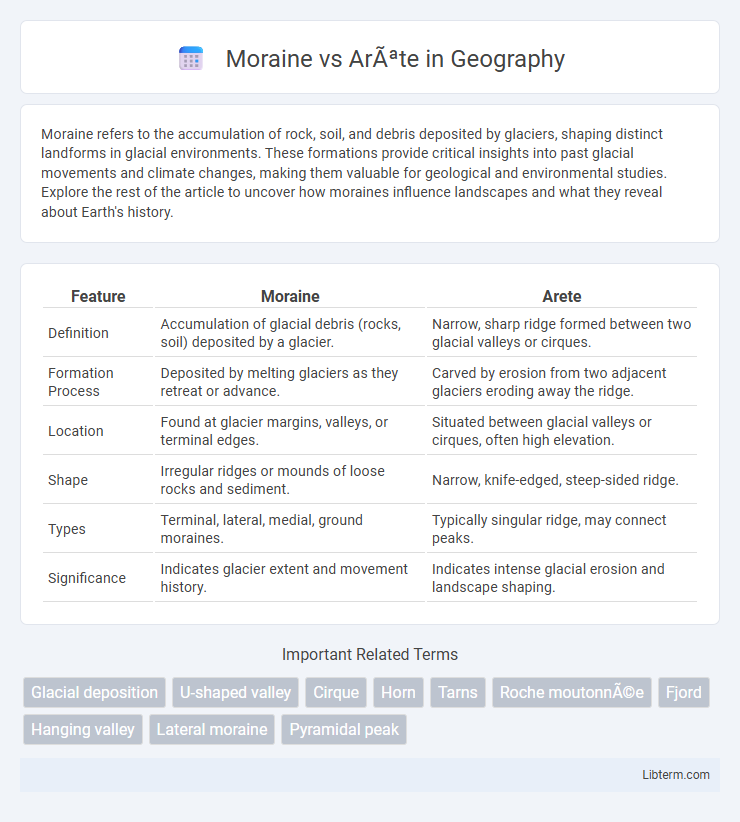Moraine refers to the accumulation of rock, soil, and debris deposited by glaciers, shaping distinct landforms in glacial environments. These formations provide critical insights into past glacial movements and climate changes, making them valuable for geological and environmental studies. Explore the rest of the article to uncover how moraines influence landscapes and what they reveal about Earth's history.
Table of Comparison
| Feature | Moraine | Arete |
|---|---|---|
| Definition | Accumulation of glacial debris (rocks, soil) deposited by a glacier. | Narrow, sharp ridge formed between two glacial valleys or cirques. |
| Formation Process | Deposited by melting glaciers as they retreat or advance. | Carved by erosion from two adjacent glaciers eroding away the ridge. |
| Location | Found at glacier margins, valleys, or terminal edges. | Situated between glacial valleys or cirques, often high elevation. |
| Shape | Irregular ridges or mounds of loose rocks and sediment. | Narrow, knife-edged, steep-sided ridge. |
| Types | Terminal, lateral, medial, ground moraines. | Typically singular ridge, may connect peaks. |
| Significance | Indicates glacier extent and movement history. | Indicates intense glacial erosion and landscape shaping. |
Introduction to Moraines and Arêtes
Moraines are accumulations of glacial debris such as soil and rock that form distinct ridges along the edges and terminus of glaciers, revealing past and present glacial movement patterns. Aretes are sharp, narrow ridges formed between two adjacent glaciers as they erode parallel valleys, creating dramatic, knife-edge landscapes common in alpine environments. These landforms provide key insights into glacial geomorphology and the dynamic processes shaping mountainous regions.
Defining Moraines: Formation and Types
Moraines are accumulations of glacial debris formed by the movement and melting of glaciers, categorized into lateral, medial, terminal, and ground moraines based on their location relative to the glacier. These landforms consist of unsorted sediment ranging from fine silt to large boulders, deposited as the glacier advances or retreats. Moraines serve as key indicators of past glacial activity and provide valuable data for understanding glacier dynamics and climate change.
Understanding Arêtes: Definition and Characteristics
An arete is a sharp, narrow ridge formed between two adjacent glacial valleys or cirques, characterized by steep, jagged sides shaped through glacial erosion. Unlike moraines, which are accumulations of glacial debris, aretes are bedrock features created by the erosive action of glaciers on either side. Their distinct knife-edge shape often indicates past glacial activity and highlights the dynamic processes of mountain landscape formation.
Geologic Processes Behind Moraines
Moraines are accumulations of glacial debris formed through processes like plucking and abrasion as glaciers advance and retreat. These deposits consist mainly of unsorted rocks, soil, and sediments transported by ice movement, which contrasts with the sharp, knife-edge ridges known as aretes, formed by the erosional action of two adjacent glaciers. The geologic processes behind moraines highlight how glaciers shape landscapes by depositing sediment, while aretes are sculpted primarily through freeze-thaw weathering and ice erosion.
How Arêtes Are Sculpted by Glacial Action
Aretes are narrow ridges formed when two glaciers erode parallel valleys, sharpening the ridge between them through freeze-thaw weathering and plucking. In contrast, moraines are accumulations of glacial debris deposited at glacier edges, reflecting the glacier's transport capacity rather than erosive shaping. The distinctive sharpness and thin profile of aretes result directly from the combined glacial sculpting on either side, highlighting dynamic glacial carving processes.
Visual Differences: Moraines vs Arêtes
Moraines appear as accumulations of glacial debris forming ridges or mounds along the valleys, often characterized by uneven, rocky terrain with mixed sediments. Aretes display sharp, narrow ridges sculpted by glacial erosion, featuring steep, knife-edge crests that clearly separate adjacent glacial valleys. Visual distinctions highlight moraines as depositional landforms with irregular shapes, while aretes stand out as erosional features with sleek, pronounced profiles.
Common Locations and Examples Worldwide
Moraines frequently form in glacier-fed valleys and mountainous regions such as the Alps, Rockies, and Himalayas, with notable examples including the Recessional Moraine in Glacier National Park, USA. Aretes are sharp, knife-edge ridges typically found between adjacent glacial valleys, prominent in the European Alps, such as the famous Aiguille du Midi in the Mont Blanc massif and the Knife Edge on Mount Katahdin in Maine, USA. Both features commonly occur in glaciated landscapes where glaciers have extensively sculpted the terrain.
Ecological Impacts of Moraines and Arêtes
Moraines influence ecological systems by altering soil composition and water drainage, creating unique habitats that support diverse plant species adapted to nutrient-poor, rocky environments. Aretes, characterized by sharp ridges, limit vegetation growth due to steep, unstable terrain, which fosters specialized alpine flora and fauna adapted to harsh conditions. Both landforms contribute to biodiversity by forming ecological niches shaped by their distinct geomorphological features.
Role in Outdoor Recreation and Adventure
Moraines serve as natural trails and obstacles in hiking and mountain biking, offering varied terrain that challenges outdoor enthusiasts. Aretes, with their sharp ridges and exposed edges, attract climbers and mountaineers seeking technical routes and scenic ridgelines. Both geological features enhance adventure experiences by providing unique landscapes for navigation, exploration, and skill development in outdoor recreation.
Comparing Moraines and Arêtes: Key Takeaways
Moraines are accumulations of glacial debris forming ridges that mark past glacier boundaries, while aretes are sharp, narrow ridges created by the erosion from two adjacent glaciers. Moraines consist primarily of till and sediment, serving as indicators of glacier movement and deposition history, whereas aretes are sculpted rock ridges emphasizing erosional processes. Understanding these features helps distinguish between depositional landforms like moraines and erosional formations like aretes in glacial geology.
Moraine Infographic

 libterm.com
libterm.com